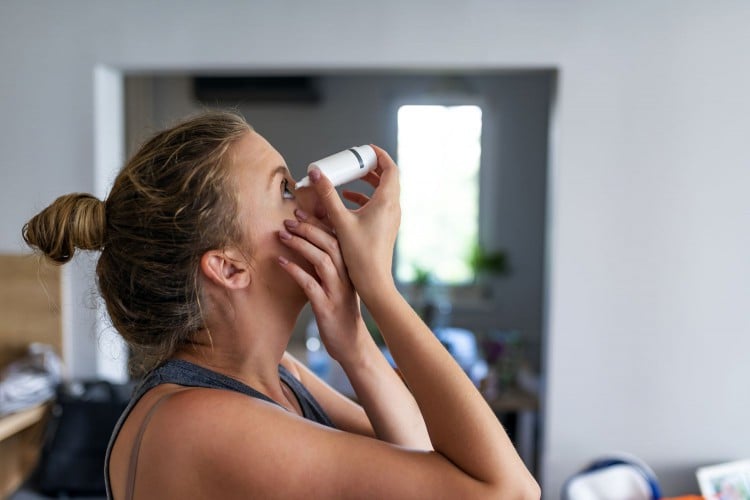- Health officials in Connecticut and New York are warning of a rare bacterial infection from the Vibrio vulnificus bacteria found in both states.
- Three people have died—two in Connecticut and one in New York—after contracting Vibrio vulnificus infections (vibriosis).
- While anyone can become infected, people who have underlying conditions or are immunocompromised are at a greater risk for severe illness.

Mariia Zotova/Getty Images
Three people have died in New York and Connecticut after coming into contact with the Vibrio vulnificus bacteria, which can cause a rare but severe infection, according to health officials.
In Connecticut, two people who died likely got the Vibrio vulnificus infection (vibriosis) after swimming in salt or brackish water in the Long Island Sound with open wounds. A third person in the state, who was hospitalized but has not died, was infected after eating raw oysters from an out-of-state establishment.
The death in New York’s Suffolk County is still being investigated to determine where the bacteria was encountered, according to a news release from the state’s department of health.
Health officials in both states are now warning residents and providers to be aware of the possibility of vibriosis, and to swim in seawater and eat raw seafood with caution.
“While rare, the vibrio bacteria has unfortunately made it to this region and can be extraordinarily dangerous,” New York Governor Kathy Hochul said in a news release. “As we investigate further, it is critical that all New Yorkers stay vigilant and take responsible precautions to keep themselves and their loved ones safe, including protecting open wounds from seawater and for those with compromised immune systems, avoiding raw or undercooked shellfish which may carry the bacteria.”
Here’s what to know about vibriosis, and how best to protect yourself.
What Is Food Poisoning?
What Is Vibriosis?
Vibriosis is a bacterial infection caused by several species of Vibrio bacteria. In these recent cases, Vibrio vulnificus bacteria is the culprit.
It's estimated that vibriosis causes 800,000 illnesses and 100 deaths in the U.S. each year, and results from people consuming raw or undercooked seafood, or exposing an open wound to seawater. Most infections occur when the weather is warm—between May and October.
Though most people who are immunocompetent will have a mild case of vibriosis, Vibrio vulnificus bacteria in particular can cause life-threatening wound infections that can lead to necrotizing fasciitis, which is why it’s commonly referred to as a “flesh-eating bacteria,” according to William Schaffner, MD, an infectious disease specialist and professor at the Vanderbilt University School of Medicine.
The Centers for Disease Control and Prevention report that people with Vibrio vulnificus infections often require intensive care or limb amputations. An estimated 1 in 5 people with the infection die, often with a day or two.
Though anyone can get vibriosis through a wound or via eating raw seafood, there are some people who may be more likely to get an infection and have it turn severe, including people who have a weakened immune system, liver disease, or are taking medication to lower stomach acid levels.
Symptoms of Vibriosis
How a Vibrio vulnificus infection presents depends on how it was acquired—whether it was through eating raw or undercooked oysters or shellfish, or if the bacteria gets into an open wound, according to Amesh Adalja, MD, a senior scholar at the Johns Hopkins Center for Health Security.
If it’s ingested, people can expect to have some gastrointestinal symptoms that typically start within 24 hours of eating the contaminated food and can last approximately three days. Those symptoms include:
- Watery diarrhea
- Abdominal cramping
- Nausea and vomiting
- Fever and chills
Vibrio vulnificus infections can also cause more severe illness when ingested, leading to bloodstream infections and severe blistering skin lesions.
If Vibrio vulnificus gets into an open wound, it can cause a life-threatening infection that can spread throughout the entire body. The symptoms of a wound infected by the Vibrio vulnificus bacteria include:
- Fever
- Redness
- Pain
- Swelling
- Warmth
- Discoloration
- Discharge (leaking fluids from the wound)
People are typically diagnosed with vibriosis if Vibrio bacteria are found in their wound, blood, or stool. People with a gastrointestinal case of vibriosis may not need any treatment other than supportive care; in more severe cases, infections are treated with antibiotics, and potentially amputation to remove dead or infected tissue.
Is Raw Fish Good for You?
Reducing Your Risk of Vibriosis
Since you can get vibriosis from raw or undercooked seafood—particularly raw oysters and shellfish—the only way to fully cook seafood to kill the bacteria. (The CDC notes that neither hot sauce nor lemon will kill Vibrio bacteria; drinking alcohol while eating oysters won’t kill it either). You also can’t tell if an oyster or other seafood contains the harmful bacteria just by look, smell, or taste.
People who are healthy or immunocompetent may be able to eat oysters without much of a risk, but some people are much more likely to get an infection or severe complication, including people who:
- Have liver disease, cancer, diabetes, HIV, or thalassemia (an inherited blood disorder)
- Receive immune-suppressing therapy
- Take medicine to decrease stomach acid levels
- Have had recent stomach surgery
Regarding wound infections from Vibrio vulnificus, the best way to reduce your chances is to stay out of saltwater or brackish water (a mix of fresh and saltwater) if you have any kind of open wound, which includes recent piercings, tattoos, or surgeries. You can also get a Vibrio wound infection if it comes into contact with raw or undercooked seafood or its juices.
“If you’re immunocompromised and have a new injury that hasn’t healed, stay out of the water,” Dr. Schaffner said. “This is the time to relax in the sun instead.”
If you must go into saltwater or brackish water with an open wound, you should cover with a waterproof bandage, and then wash wounds and cuts thoroughly with soap and water after any potential contact.








